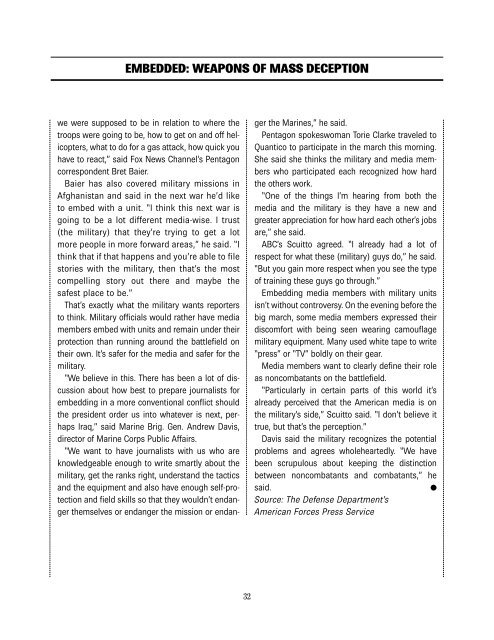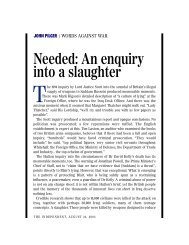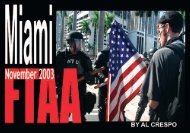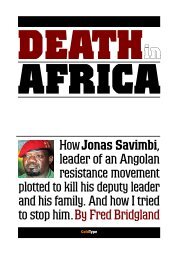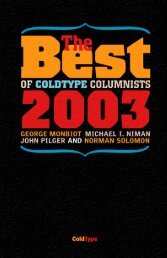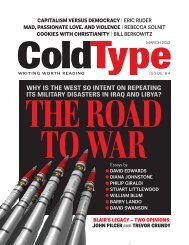UPDATED - ColdType
UPDATED - ColdType
UPDATED - ColdType
- TAGS
- updated
- coldtype
- coldtype.net
You also want an ePaper? Increase the reach of your titles
YUMPU automatically turns print PDFs into web optimized ePapers that Google loves.
EMBEDDED: WEAPONS OF MASS DECEPTION<br />
we were supposed to be in relation to where the<br />
troops were going to be, how to get on and off helicopters,<br />
what to do for a gas attack, how quick you<br />
have to react,” said Fox News Channel’s Pentagon<br />
correspondent Bret Baier.<br />
Baier has also covered military missions in<br />
Afghanistan and said in the next war he’d like<br />
to embed with a unit. “I think this next war is<br />
going to be a lot different media-wise. I trust<br />
(the military) that they’re trying to get a lot<br />
more people in more forward areas,” he said. “I<br />
think that if that happens and you’re able to file<br />
stories with the military, then that’s the most<br />
compelling story out there and maybe the<br />
safest place to be.”<br />
That’s exactly what the military wants reporters<br />
to think. Military officials would rather have media<br />
members embed with units and remain under their<br />
protection than running around the battlefield on<br />
their own. It’s safer for the media and safer for the<br />
military.<br />
“We believe in this. There has been a lot of discussion<br />
about how best to prepare journalists for<br />
embedding in a more conventional conflict should<br />
the president order us into whatever is next, perhaps<br />
Iraq,” said Marine Brig. Gen. Andrew Davis,<br />
director of Marine Corps Public Affairs.<br />
“We want to have journalists with us who are<br />
knowledgeable enough to write smartly about the<br />
military, get the ranks right, understand the tactics<br />
and the equipment and also have enough self-protection<br />
and field skills so that they wouldn’t endanger<br />
themselves or endanger the mission or endan-<br />
32<br />
ger the Marines,” he said.<br />
Pentagon spokeswoman Torie Clarke traveled to<br />
Quantico to participate in the march this morning.<br />
She said she thinks the military and media members<br />
who participated each recognized how hard<br />
the others work.<br />
“One of the things I’m hearing from both the<br />
media and the military is they have a new and<br />
greater appreciation for how hard each other’s jobs<br />
are,” she said.<br />
ABC’s Scuitto agreed. “I already had a lot of<br />
respect for what these (military) guys do,” he said.<br />
“But you gain more respect when you see the type<br />
of training these guys go through.”<br />
Embedding media members with military units<br />
isn’t without controversy. On the evening before the<br />
big march, some media members expressed their<br />
discomfort with being seen wearing camouflage<br />
military equipment. Many used white tape to write<br />
“press” or “TV” boldly on their gear.<br />
Media members want to clearly define their role<br />
as noncombatants on the battlefield.<br />
“Particularly in certain parts of this world it’s<br />
already perceived that the American media is on<br />
the military’s side,” Scuitto said. “I don’t believe it<br />
true, but that’s the perception.”<br />
Davis said the military recognizes the potential<br />
problems and agrees wholeheartedly. “We have<br />
been scrupulous about keeping the distinction<br />
between noncombatants and combatants,” he<br />
said. ●<br />
Source: The Defense Department’s<br />
American Forces Press Service


